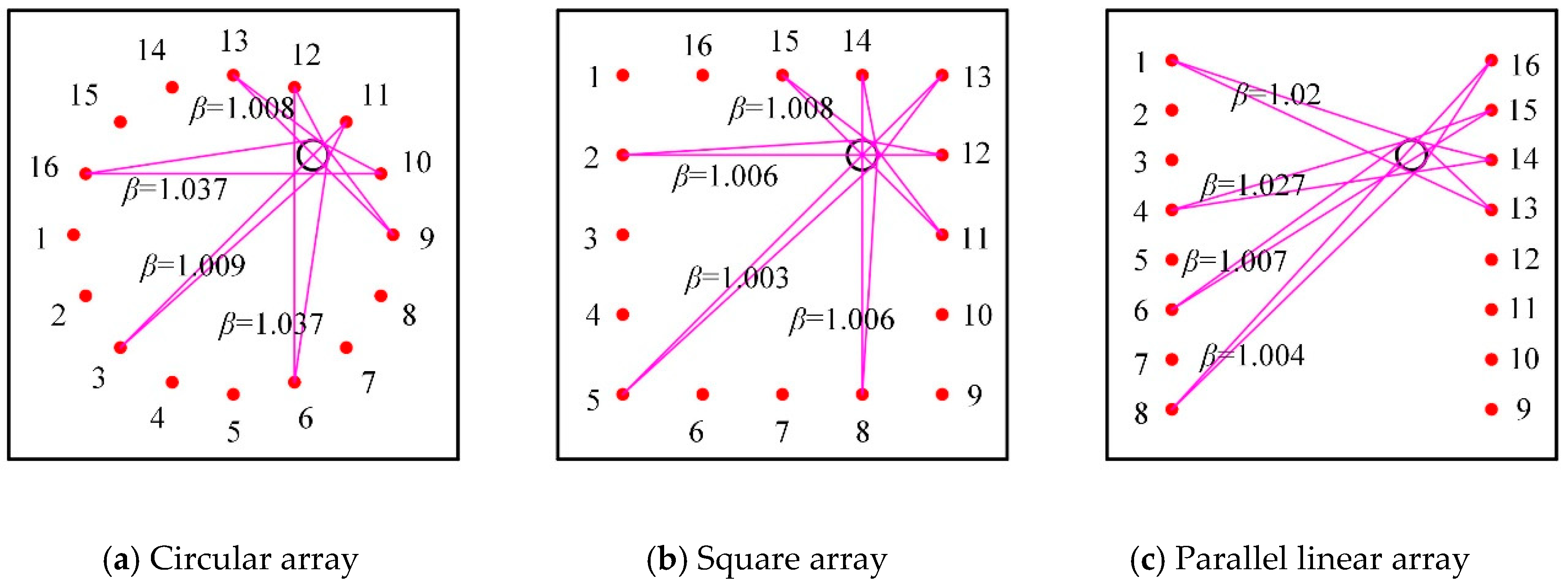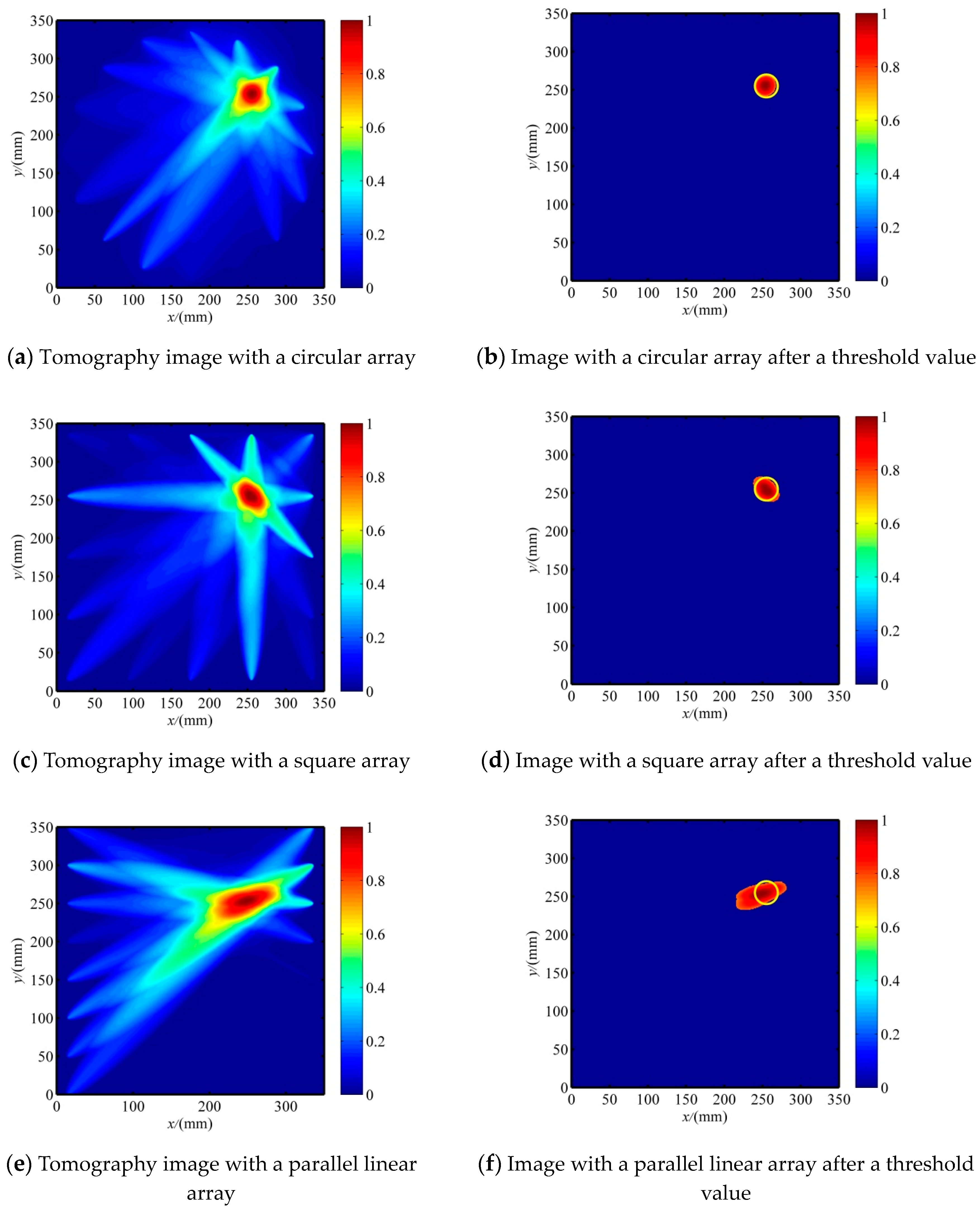Influence of the PZT Sensor Array Configuration on Lamb Wave Tomography Imaging with the RAPID Algorithm for Hole and Crack Detection
Abstract
1. Introduction
2. The RAPID Algorithm
3. Experimental Setup
4. Results and Discussion
4.1. Influence of PZT Sensor Arrays on the Images of Holes
4.2. The Improved RAPID Algorithm Based on the Evaluation of Crack Orientation
4.3. Influence of PZT Sensor Arrays on the Images for the Crack Damage
5. Conclusions
Author Contributions
Funding
Acknowledgments
Conflicts of Interest
Data Availability Statement
References
- Qing, X.; Li, W.; Wang, Y.; Sun, H. Piezoelectric Transducer-Based Structural Health Monitoring for Aircraft Applications. Sensors 2019, 19, 545. [Google Scholar] [CrossRef] [PubMed]
- Li, X.; Yang, Z.; Chen, X. Quantitative damage detection and sparse sensor array optimization of carbon fiber reinforced resin composite laminates for wind turbine blade structural health monitoring. Sensors 2014, 14, 7312–7331. [Google Scholar] [CrossRef] [PubMed]
- Khairi, M.T.M.; Ibrahim, S.; Yunus, M.A.M.; Faramarzi, M.; Sean, G.P.; Pusppanathan, J.; Abid, A. Ultrasound computed tomography for material inspection: Principles, design and applications. Measurement 2019, 146, 490–523. [Google Scholar] [CrossRef]
- Su, C.; Jiang, M.; Liang, J.; Tian, A.; Sun, L.; Zhang, L.; Zhang, F.; Sui, Q. Damage Localization of Composites Based on Difference Signal and Lamb Wave Tomography. Materials 2020, 13, 218. [Google Scholar] [CrossRef] [PubMed]
- Lambinet, F.; Sharif Khodaei, Z.; Aliabadi, F.M.H. Effectiveness of RAPID and SSM Algorithms on Composite Scarf Repair. Key Eng. Mater. 2018, 774, 535–540. [Google Scholar]
- Zhao, X.; Royer, R.L.; Owens, S.E.; Rose, J.L. Ultrasonic Lamb wave tomography in structural health monitoring. Smart Mater. Struct. 2011, 20, 105002. [Google Scholar] [CrossRef]
- Wang, D.; Ye, L.; Su, Z.; Lu, Y.; Li, F.; Meng, G. Probabilistic damage identification based on correlation analysis using guided wave signals in aluminum plates. Struct. Health Monit. 2010, 9, 133–144. [Google Scholar] [CrossRef]
- Liu, Z.; Zhong, X.; Dong, T.; He, C.; Wu, B. Delamination detection in composite plates by synthesizing time-reversed Lamb waves and a modified damage imaging algorithm based on RAPID. Struct. Control Health Monit. 2017, 24, e1919. [Google Scholar] [CrossRef]
- Sheen, B.; Cho, Y. A study on quantitative lamb wave tomogram via modified RAPID algorithm with shape factor optimization. Int. J. Precis. Eng. Man. 2012, 13, 671–677. [Google Scholar] [CrossRef]
- Lee, J.; Sheen, B.; Cho, Y. Multi-defect tomographic imaging with a variable shape factor for the RAPID algorithm. J. Visual-Japan 2016, 19, 393–402. [Google Scholar] [CrossRef]
- Zhao, J.; Miao, X.; Li, F.; Li, H. Probabilistic Diagnostic Algorithm-Based Damage Detection for Plates with Non-uniform Sections Using the Improved Weight Function. J. Vib. Eng. Technol. 2018, 6, 249–260. [Google Scholar] [CrossRef]
- Li, W.; Xu, Y.; Qing, X.; Yang, Z. Quantitative imaging of surface cracks in polymer bonded explosives by surface wave tomographic approach. Polym. Test. 2019, 74, 63–71. [Google Scholar] [CrossRef]
- Croxford, A.J.; Wilcox, P.D.; Drinkwater, B.W. Quantification of sensor geometry performance for guided wave SHM. SPIE 2009, 7295, 72951H. [Google Scholar]
- Hall, J.S.; Michaels, J.E. Analysis of distributed sparse array configurations for guided wave imaging applications. AIP Conf. Proc. 2011, 1335, 859–866. [Google Scholar]
- Chen, X.; Michaels, J.E.; Michaels, T.E. Design of distributed sparse arrays for Lamb wave SHM based upon estimated scattering matrices. AIP Conf. Proc. 2014, 1581, 248–255. [Google Scholar]
- Wu, Z.; Liu, K.; Wang, Y.; Zheng, Y. Validation and evaluation of damage identification using probability-based diagnostic imaging on a stiffened composite panel. J. Intell. Mater. Syst. Struct. 2015, 26, 2181–2195. [Google Scholar] [CrossRef]
- Dziendzikowski, M.; Dragan, K.; Katunin, A. Localizing impact damage of composite structures with modified RAPID algorithm and non-circular PZT arrays. Arch. Civ. Mech. Eng. 2017, 17, 178–187. [Google Scholar] [CrossRef]
- Guo, H.Y.; Zhang, L.; Zhang, L.L.; Zhou, J.X. Optimal placement of sensors for structural health monitoring using improved genetic algorithms. Smart Mater. Struct. 2004, 13, 528. [Google Scholar] [CrossRef]
- Gao, H.; Rose, J. Ultrasonic sensor placement optimization in structural health monitoring using evolutionary strategy. AIP Conf. Proc. 2006, 820, 1687–1693. [Google Scholar]
- Salmanpour, M.; Sharif Khodaei, Z.; Aliabadi, M. Transducer placement optimisation scheme for a delay and sum damage detection algorithm. Struct. Control Health Monit. 2017, 24, 1–20. [Google Scholar] [CrossRef]
- Ismail, Z.; Mustapha, S.; Fakih, M.A.; Tarhini, H. Sensor placement optimization on complex and large metallic and composite structures. Struct. Health Monit. 2020, 19, 262–280. [Google Scholar] [CrossRef]
- Fromme, P.; Sayir, M.B. Measurement of the scattering of a Lamb wave by a through hole in a plate. J. Acoust. Soc. Am. 2002, 111, 1165–1170. [Google Scholar] [CrossRef] [PubMed]
- Liu, H.; Chen, X.; Michaels, J.E.; Michaels, T.E.; He, C. Incremental scattering of the A0 Lamb wave mode from a notch emanating from a through-hole. Ultrasonics 2019, 91, 220–230. [Google Scholar] [CrossRef] [PubMed]
- Cai, Z. Study on the orientation detection of surface cracks by electromagnetic acoustic emission. Int. J. Distrib. Sens. Netw. 2019, 15, 1–11. [Google Scholar] [CrossRef]
- Yeasin Bhuiyan, M.; Shen, Y.; Giurgiutiu, V. Interaction of Lamb waves with rivet hole cracks from multiple directions. Proc. Inst. Mech. Eng. C J. Mech. Eng. Sci. 2017, 231, 2974–2987. [Google Scholar] [CrossRef]
- Fromme, P. Influence of guided ultrasonic wave scattering directionality on the detection sensitivity for SHM of fatigue cracks. Proc. SPIE 2010, 7650, 76501M. [Google Scholar]
- Rajagopal, P.; Lowe, M.J.S. Angular influence on the scattering of fundamental shear horizontal guided waves by a through-thickness crack in an isotropic plate. J. Acoust. Soc. Am. 2008, 124, 2021–2030. [Google Scholar] [CrossRef]
- Lu, Y.; Ye, L.; Su, Z.; Huang, N. Quantitative evaluation of crack orientation in aluminium plates based on Lamb waves. Smart Mater. Struct. 2007, 16, 1907–1914. [Google Scholar] [CrossRef]
- Wang, Q.; Xu, Y.; Su, Z.; Cao, M.; Yue, D. An Enhanced Time-Reversal Imaging Algorithm-Driven Sparse Linear Array for Progressive and Quantitative Monitoring of Cracks. IEEE Trans. Instrum. Meas. 2018, 9456, 1–13. [Google Scholar] [CrossRef]
- Yu, L.; Leckey, C.A. Lamb wave–based quantitative crack detection using a focusing array algorithm. J. Intell. Mater. Syst. Struct. 2013, 24, 1138–1152. [Google Scholar] [CrossRef]
- He, J.; Guan, X.; Peng, T.; Liu, Y.; Saxena, A.; Celaya, J.; Goebel, K. A multi-feature integration method for fatigue crack detection and crack length estimation in riveted lap joints using Lamb waves. Smart Mater. Struct. 2013, 22, 105007. [Google Scholar] [CrossRef]
- Zhou, C.; Su, Z.; Cheng, L. Quantitative evaluation of orientation-specific damage using elastic waves and probability-based diagnostic imaging. Mech. Syst. Signal Process. 2011, 25, 2135–2156. [Google Scholar] [CrossRef]
- Tua, P.S.; Quek, S.T.; Wang, Q. Detection of cracks in plates using piezo-actuated Lamb waves. Smart Mater. Struct. 2004, 13, 643–660. [Google Scholar] [CrossRef]
- Wang, Q.; Xu, J.; Wang, M.; Song, C. Lamb wave tomography technique for crack damage detection. Mech. Eng. J. 2016, 52, 30–36. [Google Scholar] [CrossRef]
- Wang, Q.; Wang, M.; Yue, D.; Su, Z. A Lamb Wave-based Crack Diagnosis Method Using an Improved RAPID Algorithm. In Proceedings of the 8th European Workshop On Structure Health Monitoring, Bilbao, Spain, 5–8 July 2016. [Google Scholar]
- Giurgiutiu, V. Tuned Lamb Wave Excitation and Detection with Piezoelectric Wafer Active Sensors for Structural Health Monitoring. J. Intell. Mater. Syst. Struct. 2005, 16, 291–305. [Google Scholar] [CrossRef]
- Lin, B.; Giurgiutiu, V. Modeling and testing of PZT and PVDF piezoelectric wafer active sensors. Smart Mater. Struct. 2006, 15, 1085–1093. [Google Scholar] [CrossRef]
- Shen, Y.; Giurgiutiu, V. Combined analytical FEM approach for efficient simulation of Lamb wave damage detection. Ultrasonics 2016, 69, 116–128. [Google Scholar] [CrossRef]











| Pattern of the PZT Sensor Array | Real Location | Predicted Location | Damage Shape Ratio | Damage Area Coverage/% |
|---|---|---|---|---|
| Circular | (255, 255) | (257, 255) | 1.0 | 92.2 |
| Square | (255, 255) | (253, 258) | 1.6 | 102.5 |
| Parallel linear | (255, 255) | (250, 255) | 3.1 | 232.1 |
| Pattern of the PZT Sensor Array | Real Location | Predicted Location | Damage Shape |
|---|---|---|---|
| Circular | (175, 175) | (176, 176) | Ellipse |
| Square | (175, 175) | (176, 176) | Oblique ellipse |
| Parallel linear | (175, 150) | (175, 151) | Elongated shape |
| Configuration Type | Real Crack Length | Predicted Crack Length | Length Error/% |
|---|---|---|---|
| Circular | 30 | 27 | 10.0 |
| Square | 30 | 26.1 | 13.0 |
| Parallel linear | 30 | 172.2 | 474 |
© 2020 by the authors. Licensee MDPI, Basel, Switzerland. This article is an open access article distributed under the terms and conditions of the Creative Commons Attribution (CC BY) license (http://creativecommons.org/licenses/by/4.0/).
Share and Cite
Wang, S.; Wu, W.; Shen, Y.; Liu, Y.; Jiang, S. Influence of the PZT Sensor Array Configuration on Lamb Wave Tomography Imaging with the RAPID Algorithm for Hole and Crack Detection. Sensors 2020, 20, 860. https://doi.org/10.3390/s20030860
Wang S, Wu W, Shen Y, Liu Y, Jiang S. Influence of the PZT Sensor Array Configuration on Lamb Wave Tomography Imaging with the RAPID Algorithm for Hole and Crack Detection. Sensors. 2020; 20(3):860. https://doi.org/10.3390/s20030860
Chicago/Turabian StyleWang, Songlai, Wanrong Wu, Yiping Shen, Yi Liu, and Shuai Jiang. 2020. "Influence of the PZT Sensor Array Configuration on Lamb Wave Tomography Imaging with the RAPID Algorithm for Hole and Crack Detection" Sensors 20, no. 3: 860. https://doi.org/10.3390/s20030860
APA StyleWang, S., Wu, W., Shen, Y., Liu, Y., & Jiang, S. (2020). Influence of the PZT Sensor Array Configuration on Lamb Wave Tomography Imaging with the RAPID Algorithm for Hole and Crack Detection. Sensors, 20(3), 860. https://doi.org/10.3390/s20030860





